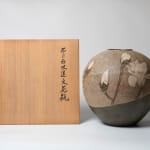ITO Motohiko 伊藤東彦 Japanese, b. 1939
H30.4 x Dia 31.7 cm
Further images
-
(View a larger image of thumbnail 1
)

-
(View a larger image of thumbnail 2
)

-
(View a larger image of thumbnail 3
)

-
(View a larger image of thumbnail 4
)

-
(View a larger image of thumbnail 5
)

-
(View a larger image of thumbnail 6
)

-
(View a larger image of thumbnail 7
)

-
(View a larger image of thumbnail 8
)

-
(View a larger image of thumbnail 9
)

-
(View a larger image of thumbnail 10
)

-
(View a larger image of thumbnail 11
)

-
(View a larger image of thumbnail 12
)

-
(View a larger image of thumbnail 13
)

-
(View a larger image of thumbnail 14
)

-
(View a larger image of thumbnail 15
)

In 1973, Ito Motohiko began using the Nunome (cloth imprinting) technique. Traditionally, potters used cloth for the purpose of easily removing clay from the mold, but Ito adapted this practice in an effort to add interesting surface texture to his works. At first, he tried many variations of his new technique, and found that iron painting produced interesting effects alongside the Nunome technique. He began using iron to outline his floral patterns, which were filled in with color slip. Many firings brought this unique combination to vivid life, producing gorgeously textured and tenderly colored surfaces that embody a sensitive observation of the natural world. To Ito, the clay is his canvas. As a traditional artist, he wraps this canvas onto all of his vessels, plates, and other ceramic works, covering his surfaces with scenes of natural beauty. Ito was born in 1939 in Fukuoka, and he loves his hometown. As he put it, “Kasama, where I have my studio, is a wonderful small town. Even though it’s only 100km from Tokyo, we have beautiful mountains, woods, fireflies, delicious rice and Sake. Also we have an old shrine and museums. This is really the perfect place for a creator. I am worried about the pollution of the environment, but I’m hoping that this beautiful town lasts for a long time. I’m also hoping that I can keep creating my work, which can provide peace within people’s minds.”
The artist received a BFA in 1964 and an MFA in 1966, both from Tokyo Art University, where he studied with Kato Hajime 加藤土師萌(1900-1968) and Fujimoto Nodo藤本能道(1919-1992). He worked at a tile company after graduating, but quit after two years to continue his studies, first with Matsui Kosei and then at the Ibrarki Pottery Research Center. He established his own kiln in Kasama in 1970, and has since received many awards and accolades, including a solo exhibition at the Ibaraki Ceramic Art Museum in 2001.














